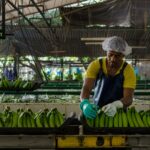Colombia, an emerging market in Latin America

By Carolina De Francesco
Colombia is the second most populated country in Latin America with 52 million inhabitants, second only to Brazil. Its surface area of 1.141 million km² makes it the 4th largest country in the region and the 2nd most densely populated after Ecuador.
It has several peculiarities. Despite being the most stable democracy in Latin America, for 50 years the country went through conflicts with armed groups. However, the panorama has changed in recent years, due to the frontal combat with these groups and a sustained process of economic opening.
Its location in an intertropical zone guarantees high irradiation and a high average temperature throughout the year. It also has one of the lowest water stress levels in the region. This allows it to sustain operations throughout the year and to take advantage of production windows in other countries.
Additionally, being a mountainous country, it has different thermal floors that allow it to exploit different varieties of products. Fruit production is especially important in the Andean and Amazon regions, and to a lesser extent in the Caribbean region, with more marginal production in the Pacific and Orinoquia regions.
According to FAO, Colombia has more than 50% of the land with agricultural potential that is still untapped, so the capacity to expand the sector is still very important.
Connectivity is also a factor of competitiveness, whether by air or sea. Its geographical position gives it good access to northern hemisphere markets: ships can be in the United States in five days or in the Netherlands in 12. The main ports of connection are Cartagena and Barranquilla, both with access to the Caribbean/Atlantic Sea; but it also has ports on the Pacific.
The country is emerging as one of the main suppliers of fruits and vegetables in the world in the coming years, having good entry into markets with high-quality requirements. The fresh fruit and vegetable market in 2024 is estimated at a size of US$6.4 billion, and is expected to grow at a rate of 4.9% per annum over the next five years.
Local production is being strongly stimulated by the government, with different initiatives aimed not only at increasing production but also at improving the quality of life and income of Colombian farmers. There are also specialized entities that provide support in the areas of health and safety, R&D, production management, and financing, among others.
An interesting fact is that there are more than 400 native edible fruits identified in the country, making it the first country in the world in terms of fruit biodiversity per square kilometer. However, many are little known or are not exploited on a commercial scale.
Among its products are fruits such as bananas, mango, pineapple, papaya, strawberries, and avocado. Undoubtedly, the region's star crop is bananas, given their high exportable production and wide distribution network. Colombia is the fifth largest exporter of bananas globally, exporting more than 90% of its production. Of that total, more than half is exported to Europe and the United States. It is also a major global supplier of avocados, ranking among the world's top 5 exporters.
In addition, fruit consumption is increasing in the country due to the greater appreciation of healthy eating among consumers. This growing demand for fresh produce has boosted imports, to the point that they have increased at a higher rate than the global rate. This increase in imports is strongly supported by retail market chains, which have expanded strongly throughout the country.
Among the fruits most imported into the country are fresh apples and pears, grapes, mangoes, and mangosteens, among others. As an import market, Colombia is of special interest to Latin American countries. In the case of apples, it buys mainly from Chile and some from Brazil. This fruit is by far the most consumed of the imported fruits.
It also buys pears from Chile and to a lesser extent from Argentina. In grapes, the main suppliers are Peru and Chile, followed far behind by Argentina and Ecuador. In citrus, it mainly buys mandarins from Peru and Chile (and occasionally from Uruguay), as local mandarins are not of good quality.










































